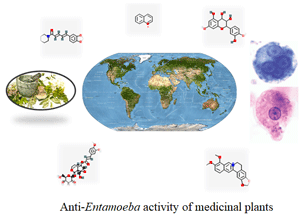Crossref Citations
This article has been cited by the following publications. This list is generated based on data provided by
Crossref.
Nekoei, Shahin
Khamesipour, Faham
Habtemariam, Solomon
de Souza, Wanderley
Mohammadi Pour, Pardis
and
Hosseini, Seyed Reza
2022.
The anti‐Trypanosoma activities of medicinal plants: A systematic review of the literature.
Veterinary Medicine and Science,
Vol. 8,
Issue. 6,
p.
2738.
Chelgerdi Dehkordi, Bahareh
Karimi-Dehkordi, Maryam
and
Khamesipour, Faham
2022.
Induction of apoptosis by hydroalcoholic and methanolic extract of Deracocephalum kotschyi on Trichomonas vaginalis.
Journal of Parasitic Diseases,
Vol. 46,
Issue. 3,
p.
686.
Pourmohammad, Amir Hossein
Khamesipour, Faham
and
Jafarian-Dehkordi, Mohsen
2022.
In Vivo Anti-Toxoplasma Effects of Dracocephalum polychaetum Essential Oil.
Modern Care Journal,
Vol. 19,
Issue. 1,
Khamesipour, Faham
Pourmohammad, Amirhossein
Jafarian-Dehkordi, Mohsen
and
Behzadi, Payam
2022.
Anti-Toxoplasma Effects of Dracocephalum Polychaetum Essential Oil.
Interdisciplinary Perspectives on Infectious Diseases,
Vol. 2022,
Issue. ,
p.
1.
Estrella-Parra, Edgar Antonio
Arreola, Rodrigo
Álvarez-Sánchez, Maria Elizbeth
Torres-Romero, Julio César
Rojas-Espinosa, Oscar
De la Cruz-Santiago, José Alberto
Martinez-Benitez, Máximo Berto
López-Camarillo, Cesar
Lara-Riegos, Julio Cesar
Arana-Argáez, Víctor E.
and
Ramírez-Camacho, Mario A.
2022.
Natural marine products as antiprotozoal agents against amitochondrial parasites.
International Journal for Parasitology: Drugs and Drug Resistance,
Vol. 19,
Issue. ,
p.
40.
Bhatia, Meenakshi
Kumar, Sunil
Kapoor, Archana
and
Lohan, Sunidhi
2022.
A Review on the Drug Delivery Strategies for Parasitic Infections: Scope
and Assertion.
Drug Delivery Letters,
Vol. 12,
Issue. 2,
p.
109.
Ranasinghe, Sandamalie
Aspinall, Sasha
Beynon, Amber
Ash, Amanda
and
Lymbery, Alan
2023.
Traditional medicinal plants in the treatment of gastrointestinal parasites in humans: A systematic review and meta‐analysis of clinical and experimental evidence.
Phytotherapy Research,
Vol. 37,
Issue. 9,
p.
3675.
Yang, Longhao
Zhu, Yingying
Zhang, Wenli
and
Mu, Wanmeng
2024.
Recent progress in health effects and biosynthesis of lacto-
N
-tetraose, the most dominant core structure of human milk oligosaccharide
.
Critical Reviews in Food Science and Nutrition,
Vol. 64,
Issue. 19,
p.
6802.
Alrasheid, Ayat Ahmed
Kabbashi, Ahmed Saeed
Ali, Amar Osman
Alrasheed, Amel Ahmed
Kanani, Zeinab
Saleh, Missa Mohammed
Zengin, Gokhan
and
Ayoub, Saad Mohammed Hussein
2024.
Nutritional Value and in vitro Antigiardial Activity of Anise (Pimpinella anisum L.) Seeds.
Chemistry & Biodiversity,
Vol. 21,
Issue. 3,
Diseko, Letlhogonolo J.
Tsotetsi-Khambule, Ana M.
Onyiche, ThankGod E.
Ramatla, Tsepo
Thekisoe, Oriel
and
Gcebe, Nomakorinte
2024.
Coxiella burnetii infections from animals and ticks in South Africa: a systematic review.
Veterinary Research Communications,
Vol. 48,
Issue. 1,
p.
19.
